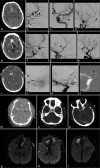Rapid sequential development and rupture of mycotic aneurysms within a period of days in a patient with graft-versus-host disease and angiotropic Scedosporium apiospermum infection
- PMID: 35855168
- PMCID: PMC9282729
- DOI: 10.25259/SNI_970_2021
Rapid sequential development and rupture of mycotic aneurysms within a period of days in a patient with graft-versus-host disease and angiotropic Scedosporium apiospermum infection
Abstract
Background: Fungal origin mycotic aneurysms are rare and carry a high mortality rate. Scedosporium apiospermum is an ubiquitous fungus which has been described to cause devastating infections in immunocompromised hosts.
Case description: We report a case of a 23-year-old patient with Burkitt's lymphoma and graft-versus-host disease admitted with intracerebral hemorrhage and sequential development of 12 anterior circulation aneurysms from disseminated Scedosporium infection. Despite aggressive surgical and antimicrobial treatment, the patient died 6 months later from multiorgan failure. The notable feature of this case is the rapid angioinvasiveness of the infection with new aneurysm formation within days of clear angiographic imaging despite the apparent lack of skull base osteomyelitis.
Conclusion: We highlight the difficulties in treating fungal mycotic aneurysms and the associated high mortality. While a less aggressive approach might have been appropriate given the known poor outcomes, the age of the patients as well as the family wishes dictated the treatment decisions.
Keywords: Mycotic aneurysm; Scedosporium apiospermum; Surgery.
Copyright: © 2022 Surgical Neurology International.
Conflict of interest statement
There are no conflicts of interest.
Figures

Similar articles
-
Skull base osteomyelitis secondary to Scedosporium apiospermum infection.Radiol Case Rep. 2018 Jun 6;13(4):759-763. doi: 10.1016/j.radcr.2018.05.005. eCollection 2018 Aug. Radiol Case Rep. 2018. PMID: 29887928 Free PMC article.
-
Mycotic osteomyelitis due to Scedosporium Apiospermum: MR imaging-pathologic correlation.Skeletal Radiol. 2003 Nov;32(11):656-60. doi: 10.1007/s00256-003-0695-0. Epub 2003 Sep 23. Skeletal Radiol. 2003. PMID: 14504834
-
Pathology of hyalohyphomycosis caused by Scedosporium apiospermum (Pseudallescheria boydii): an emerging mycosis.Hum Pathol. 1998 Nov;29(11):1266-72. doi: 10.1016/s0046-8177(98)90255-6. Hum Pathol. 1998. PMID: 9824105
-
Case of femoral pseudarthrosis due to Scedosporium apiospermum in an immunocompetent patient with successful conservative treatment and review of literature.Mycoses. 2018 Jun;61(6):400-409. doi: 10.1111/myc.12739. Epub 2018 Jan 23. Mycoses. 2018. PMID: 29274090 Review.
-
Cutaneous Scedosporium apiospermum infection in an immunocompromised patient and a review of the literature.Acta Derm Venereol. 2005;85(2):156-9. doi: 10.1080/00015550410024553. Acta Derm Venereol. 2005. PMID: 15823912 Review.
Cited by
-
Scedosporiosis and lomentosporiosis: modern perspectives on these difficult-to-treat rare mold infections.Clin Microbiol Rev. 2024 Jun 13;37(2):e0000423. doi: 10.1128/cmr.00004-23. Epub 2024 Mar 29. Clin Microbiol Rev. 2024. PMID: 38551323 Free PMC article. Review.
References
-
- Baudrillard JC, Rousseaux P, Lerais JM, Toubas O, Scherpereel B, Gari M, et al. Fungal mycotic aneurysms and multiple cerebral abscesses caused by Scedosporium apiospermum. Apropos of a case with review of the literature. J Radiol. 1985;66:321–6. - PubMed
-
- Ducruet AF, Hickman ZL, Zacharia BE, Narula R, Grobelny BT, Gorski J, et al. Intracranial infectious aneurysms: A comprehensive review. Neurosurg Rev. 2010;33:37–46. - PubMed
-
- Gosbell IB, Morris ML, Gallo JH, Weeks KA, Neville SA, Rogers AH, et al. Clinical, pathologic and epidemiologic features of infection with Scedosporium prolificans Four cases and review. Clin Microbiol Infect. 1999;5:672–86.
-
- Hart RG, Foster JW, Luther MF, Kanter MC. Stroke in infective endocarditis. Stroke. 1990;21:695–700. - PubMed
